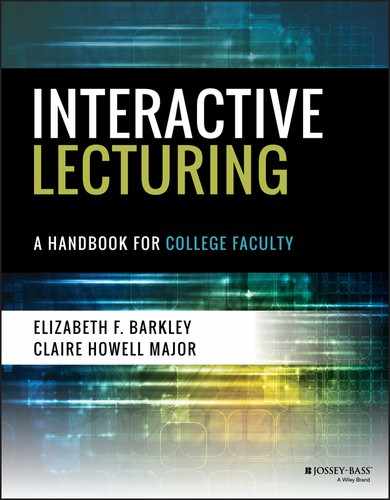ENGAGING LECTURE TIP 23
Lecture Map
Despite your best efforts to craft a clear and logically coherent lecture, sometimes an audience needs additional guidance in order to follow your train of thought. This is particularly true when the audience is unfamiliar with your topic. A Lecture Map provides such guidance through a representation of the key areas or intellectual structure of the lecture content.
Using a Lecture Map can help students understand the lecture as a conceptual whole. It can help orient them to the content by conveying the central concepts you will cover and illustrate how the pieces fit together. A Lecture Map also helps students maintain focus and attention by encouraging them to actively seek to fill in the gaps between those key pieces. In addition, because the Lecture Map provides an itinerary of sorts for the lecture, it is helpful for students to know where they are at a given moment during the talk, which helps them to focus on what you are saying. A Lecture Map makes an excellent handout that can also help students structure their notes according to the key points.
A Lecture Map can range from a simple listing of topics to a complex graphic of the lecture content. To create a Lecture Map, complete the following steps:
- Determine the scope of your map. For this, you should have already developed the lecture content (see Chapter 4 for Tips on how to generate the content) and now have a good idea of how to bound the content to illustrate it in the map.
- Consider what you will include on your map. You may choose key concepts (see Tip 5: Sticky Note Diagrams for a process for identifying them) or organizational elements from other Tips, such as Tip 7: Logical Patterns and Tip 15: Signposts.
- Determine how detailed your map will be. You will typically choose three to five key points, but if you are using Tip 9: Linked Lecturettes, you may choose to join more concepts together.
- Consider how the ideas may be best visually represented. You may want to use a list or outline. You could choose a graphic organizer, such as a flow chart, a concept map, a Venn diagram, or a free-form, loose, spatial arrangement. Alternately, you may want to consider creating your own Sketch Notes (Technique 17) to serve as a lecture map.
- Choose how you will create the map. You may choose a simple word processing program and use drawing features such as SmartArt, but there are also several mapping programs available online for free use (e.g., Popplet or Bubbl.us) that can help in creating more complex maps. Or you may want to do it by hand.
- Create a handout so that students can keep the map visible at all times.
Although a Lecture Map makes an excellent handout, if you prefer, you can hang a Lecture Map somewhere in the classroom (or post it online). If you choose this route, you should ensure that students can see the map at all times during the lecture.
In addition to a map of a specific lecture, you can also consider creating a larger map of the full course content, mapping out where each lecture fits within the broader context of the course content.
Key References and Resources
- Gooblar, D. (2013c). Lecture map. Pedagogy Unbound. Retrieved from www.pedagogyunbound.com/tips-index/2013/8/23/make-a-lecture-map-to-help-students-follow
- Sarma, R. (2015). Guest lecture to biomed department. Retrieved from http://slideplayer.com/slide/4716954/
- Staley, C. (2003). Fifty ways to leave your lectern. Belmont, CA: Wadsworth/Cengage Learning.
- Tsou, T. (2015). Geographic and spatial reasoning. Retrieved from http://map.sdsu.edu/geog104/lecture/unit-2.htm
- Walker, J. (n.d.). Emerging trends and technologies. Retrieved from http://slideplayer.com/slide/6321152/
